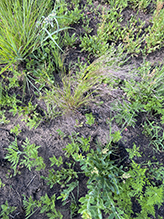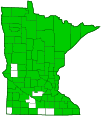rough bentgrass
(Agrostis scabra)
Conservation • Wetland • Description • Habitat • Ecology • Use • Distribution • Taxonomy
Description |
||
Rough bentgrass, also called ticklegrass, is a widespread and very common grass. It is native to eastern Asia and North America. In North America it has been recorded in every state and province except Oklahoma, but it is uncommon to rare in the southeast and in the lower Midwest United States, and uncommon in the Canadian high arctic. It is very common in Minnesota. It is found in a wide variety of habitats and grows in a wide range of conditions. It is found in open woodlands and forest openings; in prairies, shrublands, and meadows; in swamps, bogs, and marshes; on stream and lake margins; and on roadsides, in ditches, and in other disturbed areas. It grows under full sun, but it is tolerant of shade. It grows in soil that is moist, moderately moist, or dry, that may be sandy, gravelly, or loamy. It is a pioneer species, one of the first to invade recently disturbed areas, including abandoned fields and forest clearcuts. It flowers from June to September depending on location and it sheds its seeds in late summer. At a distance a group of mature tufts looks like a purple haze. Rough bentgrass is a perennial, cool season (C3) grass that rises on basal leaves and a clump of multiple stems from a fibrous root system. It does not form underground horizontal stems (rhizomes) or produce above-ground runners (stolons). The stems (culms) are hairless, round in cross section, unbranched, and 6″ to 36″ (15 to 90 cm) tall. They may be erect or curve upward from the base (ascending). There are usually 1 to 3 areas (nodes) below the middle of the stem from which the leaves emerge. The nodes are slightly swollen, dark, and hairless. Between the nodes the stem is hollow. Most of the leaves are basal. Basal leaves are linear, 1½″ to 5½″ (4 to 14 cm) long, 1⁄32″ to ⅛″ (1 to 3 mm) wide. The upper surface is slightly rough to the touch and the margins are rolled inward toward the upper side. Basal leaves are usually present at flowering time. Stem leaves are similar, but the blade is shorter and flat. The base of the leaf that wraps around the stem (sheath) is open, hairless, and usually smooth, sometimes minutely roughened. The collar is not strongly developed. It does not have developed shoulders, ear-like projections (auricles), or hairs on the sides. The ligule is membranous, translucent, 1⁄16″ to 3⁄16″ (2 to 5 mm) long, and irregularly torn at the top. The inflorescence is a branched arrangement (panicle) at the end of each flowering stem. The panicle is diffuse, reddish-purple, broadly egg-shaped in outline, 3″ to 10″ (8 to 25 cm) long, rarely longer, and 3⁄16″ to 8″ (0.5 to 20 cm) wide, often as wide as long. At maturity the panicle often detaches as a unit at the base, forming a tumbleweed. The lowest node has 2 to 7 branches. Lower branches are 1½″ to 4¾″ (4 to 12 cm) long. The branches are widely spreading to ascending, sometimes drooping, flexible, rough to the touch, and branched again above the middle. The spikelets are well spaced, not crowded, at the ends of the branchlets. The spikelets are lance-shaped and greenish-purple at first, often purple at maturity. Each spikelet has a lower and an upper sterile bract (glume) at the base and a single floret. The glumes are lance-shaped, keeled, and rough, at least toward the tip. The lower glume is 1⁄16″to ⅛″ (1.8 to 3.4 mm) long. Subtending the floret there is and outer bract (lemma) and an inner bract (palea). The lemma is 1⁄32″ to 1 ⁄16″ (1.4 to 2.0 mm) long and narrowed to a slender point at the tip. Five prominent veins are visible on the outer surface. There may be a 1⁄128″ to ⅛″ (0.2 to 3.0 mm) long bristle-like extension of the midvein (awn) at the tip. Sometimes there is no awn. The palea is minute, up to 1⁄128″ (0.2 mm) long, or is sometimes absent. There are three stamens. The anthers are 1⁄64″ to 1 ⁄32″ (0.4 to 0.8 mm) long. |
||
Height |
||
6″ to 36″ (15 to 90 cm) |
||
Similar Species |
||
Habitat |
||
Moist, moderately moist, or dry. Open woodlands, forest openings, prairies, shrublands, meadows, swamps, bogs, marshes, stream sides, lake margins, roadsides, ditches, and other disturbed areas. Full sun. Sandy, gravelly, or loamy soil. |
||
Ecology |
||
Flowering |
||
June to September |
||
Pests and Diseases |
||
|
||
Use |
||
|
||
Distribution |
||||
|
Sources |
|||
| 11/5/2022 | ||||
Nativity |
||||
Native |
||||
Occurrence |
||||
Very common |
||||
Taxonomy |
|||
| Kingdom | Plantae (Plants) | ||
| Subkingdom | Pteridobiotina | ||
| Phylum | Tracheophyta (Vascular Plants) | ||
| Class | Liliopsida (Monocots) | ||
Order |
Poales (grasses, sedges, cattails, and allies) | ||
Family |
Poaceae (grasses) | ||
| No Rank | BOP clade | ||
| Subfamily | Pooideae | ||
| Supertribe | Poodae | ||
| Tribe | Poeae | ||
| Subtribe | Agrostidinae | ||
Genus |
Agrostis (bent grass) | ||
Subordinate Taxa |
|||
Up to six varieties have been described in the past, but no subspecies are currently recongized. |
|||
Synonyms |
|||
Agrostis geminata Agrostis hyemalis Agrostis laxa Agrostis laxiflora Agrostis nootkaensis Agrostis nutkaensis Agrostis peckii Agrostis scabrata Agrostis scabriuscula Agrostis torreyi Trichodium album Trichodium laxiflorum Trichodium montanum Trichodium scabrum Vilfa scabra |
|||
Common Names |
|||
hair grass rough hair grass rough-hair grass rough bent rough bentgrass southern hair grass tickle grass ticklegrass winter bent grass |
|||
Glossary
Ascending
Growing upward at an angle or curving upward from the base.
Collar
In grasses: The area on the back of a grass leaf at the junction of the sheath and the blade. On moths: the upperside of the prothorax.
Culm
The hollow or pithy stem of a grass, sedge, or rush.
Glume
A chaffy, empty, sterile bract at the base of a grass spikelet. Glumes usually occur in pairs, but occasionally only one is present.
Lemma
The outer, lowermost of the pair of bracts at the base of the grass floret; it ensheathes the palea.
Ligule
In grasses and sedges, an outgrowth on the leaf at the junction of the blade and the sheath, usually membranous, sometimes no more than a fringe of hairs. In flowering plants, the ligule is the flat, strap-shaped, petal-like portion of the corolla of a ray floret.
Linear
Long, straight, and narrow, with more or less parallel sides, like a blade of grass.
Node
The small swelling of the stem from which one or more leaves, branches, or buds originate.
Panicle
A pyramidal inflorescence with a main stem and branches. Flowers on the lower, longer branches mature earlier than those on the shorter, upper ones.
Rhizome
A horizontal, usually underground stem. It serves as a reproductive structure, producing roots below and shoots above at the nodes.
Sheath
The lower part of the leaf that surrounds the stem.
Stolon
An above-ground, creeping stem that grows along the ground and produces roots and sometimes new plants at its nodes. A runner.
Cool Season or Warm Season?
Rough bentgrass flowers in the summer, from July to September, but it is classified as a cool season grass. All grasses in the BOP clade (sometimes called the BEP clade) are cool season grasses.
As the names suggest, cool season grasses tend to flower in the spring and warm season grasses tend to flower in the summer. The term “cool season” is shorthand for C3. It is the “normal” photosynthetic pathway common to most plants, in which the first carbon compound produced contains three carbon atoms, and oxygen is eliminated through photorespiration. The term “warm season” is shorthand for C4, in which a four-carbon atom compound is produced, carbon is separated from oxygen in specialized cells, and photorespiration is not required.
Rough bentgrass is a C3. grass that flowers in the warm season.
Visitor Photos |
|||||
Share your photo of this plant. |
|||||
| This button not working for you? Simply email us at info@MinnesotaSeasons.com. Attach one or more photos and, if you like, a caption. |
|||||
Nancy Falkum |
|||||
 |
|||||
MinnesotaSeasons.com Photos |
|||||
|
|||||

Slideshows |
||
| Agrostis scabra - rough bentgrass Matt Lavin |
||
 |
||
About
Rough bentgrass is a perennial bunchgrass, likely short lived, common to roadsides and trailsides. The inflorescence bears spikelets only at the branch ends, thus the long naked inflorescence branches are distinctive. Also, the entire inflorescence senesces and abscises from the basal leaf bunch and drifts away as a tumble grass. |
||

Visitor Videos |
|||
Share your video of this plant. |
|||
| This button not working for you? Simply email us at info@MinnesotaSeasons.com. Attach a video, a YouTube link, or a cloud storage link. |
|||
Other Videos |
|||
| Tickle Grass Agrostis scabra Update - Native Grass Cricket for Baseball People |
|||
About
Jun 9, 2022 I'm experimenting with this native grass to see if it's suitable as a cool season (C3) grass for a blend of C3/C4 grasses on a sporting (cricket) field. I want to see how it behaves when I mow it, and how well it tolerates dry conditions without watering. |
|||

Visitor Sightings |
|||||
Report a sighting of this plant. |
|||||
| This button not working for you? Simply email us at info@MinnesotaSeasons.com. Be sure to include a location. |
|||||
| Nancy Falkum 6/26/2022 |
Location: Weaver Dunes Preserve, Cox Unit |
||||
MinnesotaSeasons.com Sightings |
|||||

Created: 11/5/2022
Last Updated:

